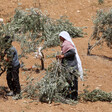Activism and BDS Beat 13 August 2019

Research group Forensic Architecture found this unexploded bullet manufactured by Sierra Bullets in the sand near al-Bureij refugee camp in central Gaza mid-July. (via Twitter)
Warren B. Kanders resigned last month as vice chair of New York’s Whitney Museum of American Art.
This came amid mounting criticism of how he supplies the Israeli and US militaries with weapons.
But renowned conceptual artist Michael Rakowitz says the resignation is not enough.
Rakowitz was the first to withdraw from the latest Whitney Biennial, a prestigious showcase of American art held every two years.
He took the decision to protest Kanders’ involvement in the weapons trade and in solidarity with some 100 museum workers who demanded the vice chair’s resignation.
Several artists followed suit in July.
Kanders owns the Safariland Group, which he bought from the British arms giant BAE Systems in 2012.
Based in Florida, the company produces tear gas canisters, bomb-defusing robots and gun holsters, some of which are believed to have been used by US forces along the border with Mexico and by Israeli troops at the Gaza boundary fence.
Kanders also commands a significant stake in Sierra Bullets, which sells ammunition to Israeli government-owned weapons manufacturer IMI Systems, a “preferred supplier” of the Israeli army.
Rakowitz told The Electronic Intifada he felt “very moved” when he learned last month that Kanders had stepped down.
The resignation followed a series of protests against Kanders’ investments.
The protests came after the art publication Hyperallergic drew attention last year to Kanders’ work in the weapons industry.
“Non-lethal” products
“We read the Hyperallergic article and felt not annoyed, not intellectually upset – we felt sick to our stomachs, we shed tears, we felt unsafe,” museum staffers wrote in their statement.
Kanders doubled down in response, asserting that he is “exceptionally proud” of his company.
He also boasted of the “non-lethal products,” such as tear gas canisters, that his company manufactures “as an alternative to lethal solutions.”
But in the hands of the Israeli army, tear gas canisters are indeed lethal.
Israeli forces killed at least seven Palestinians using tear gas canisters since the beginning of Gaza’s Great March of Return, including four children, according to Israeli human rights group B’Tselem.
Palestinian refugees have held unarmed protests almost weekly since 30 March 2018 to demand that Israel end the siege of Gaza and respect their right to go home.
Rakowitz said that “the shape and size of the Campbell’s soup cans that feature in the work of Andy Warhol, whose work was on exhibit at the Whitney,” resembled those of tear gas canisters.
Kanders provided major funding for the Warhol show.
“Suddenly, I could not unsee those soup cans transforming into tear gas canisters,” Rakowitz added.
This is not the first time Rakowitz has withheld his work from an exhibition for ethical reasons.
“The letter I wrote to the curators of the Whitney Biennial continues the long list of letters I have written to Israeli institutions or exhibitions at museums elsewhere,” Rakowitz said.
The artist endorses BDS – the boycott, divestment and sanctions movement for Palestinian rights, including the academic and cultural boycott of Israel.
“Long struggle”
Rakowitz believes that Kanders’ decision to step down does not go far enough because his resignation “did not dissolve the factories manufacturing these weapons.”
“Those tear gas canisters and bullets will remain ready for use against oppressed bodies around the world,” the artist added.
“And we must be clear with ourselves that while we may have reached our objectives in this one instance in one museum in one city, our long struggle is much bigger and goes beyond the cultural field.”
Rakowitz recalled that he was about to attend a presentation on tear gas by the Palestinian artist Emily Jacir in Dublin when he heard Kanders had resigned.
Jacir has found tear gas canisters manufactured by Safariland which were used in the occupied West Bank city of Bethlehem.
The research group Forensic Architecture has collected evidence suggesting that the Israeli army has fired bullets made by the Sierra firm at people taking part in the Great March of Return.
A Forensic Architecture researcher recently found a bullet manufactured by Sierra in the sand near al-Bureij refugee camp in central Gaza.
Since the Great March of Return began in March 2018, Israeli snipers have killed more than 200 Palestinians during protests and injured thousands more with live ammunition.An independent UN commission of inquiry found that Israel’s use of lethal force against protesters may amount to war crimes and crimes against humanity.
The European Center for Constitutional and Human Rights has informed Sierra Bullets that it intends to file a lawsuit against the manufacturer for aiding and abetting war crimes.
Correction: This article initially stated that Israeli forces killed at least seven Palestinians using tear gas canisters so far this year. In fact, the figure is from the beginning of the Great March of Return in March 2018.




